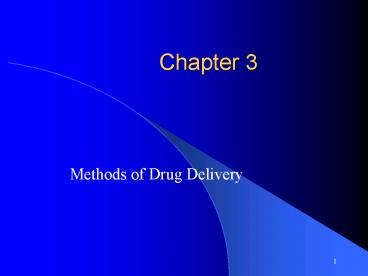Methods of Drug Delivery PowerPoint PPT Presentation
1 / 26
Title: Methods of Drug Delivery
1
Chapter 3
- Methods of Drug Delivery
2
Delivery of Drugs
- Enteral digestive tract
- Parenteral major route Given into the
cardiovascular circulation - Topical by application onto the skin or
associated membranes
3
Process of Drug Delivery
- Drug Administration Phase depends on form of
med, speed medication action is needed, desired
location - Enteral
- Parenteral
- Topical
4
Process of Drug Delivery
- Pharmacokinetic Phase movement of drugs
throughout the body to various targets - Absorption
- Distribution
- Metabolism
- Excretion
5
Process of Drug Delivery
- Pharmacodynamic Phase drugs produce a change or
an effect at a specific target (receptor) - Efficacy
- Potency
6
Physical Properties
- Influence how medications enter and move
throughout the body
7
Physical Properties
- Solids most effective via a body opening, need
to dissolve first to become active, which slows
the process
8
Physical Properties
- Liquids- move quicker through the body but need
to penetrate the cellular membrane, viscosity can
make it more difficult if it is higher,
solubility the ability to dissolve will affect
how easily it passes across the membrane
9
Physical Properties
- Hydrophobic- dissolve in lipids, work better
penetrating body membranes
10
Physical Properties
- Hydrophilic dissolve in water, work better in
the bloodstream
11
Physical Properties
- Gas
- Fast absorption, moves quicker to target area
and action is in seconds
12
Oral Route
- By mouth
- Can be chewed, swallowed, or dissolved in the
mouth - Tablets, capsules, powders, solutions,
suspensions - Dissolution delays the onset of action, water is
needed or may be taken with food
13
Sublingual
- Absorbed quickly into the bloodstream
- Avoid the first- pass effect intestinal
absorption into the portal circulation to the
liver to be metabolized by the liver
14
Rectal
- Use with unconscious patients, patients with N/V,
infants not able to swallow pills - Rapid onset of action due to blood supply
15
Injection Into the Blood Vessels
- IV
- Bolus
- Infusion
- Bypasses destructive enzymes of GI tract and the
liver - Fluid overload, infection
16
Injections
- Intradermal dermis
- easily
absorbed - Subcutaneous hypodermis
- Intramuscular muscles
- faster onset of
action
17
Injections
- Advantage IM and subcutaneous
- Concentration of drug is predictable
- Confined to a precise location
- May be given to unconscious patients and children
- Disadvantage IM and subcutaneous
- Pain, swelling, tissue damage, infection
18
Injections
- Intrathecal directly in spinal subarachnoid
space(dorsal spine spinal cavity beneath a sheath
surrounding the spinal cord called the anrachnoid
mater) spinal anesthetics or medications that
might enter the cerebral spinal fluid
19
Injections
- Epidural directly into a space overlying the dura
mater (most superficial layer of that protects
the CNS)
20
Injections
- Intraperitoneal directly into the abdominal cavity
21
Injections
- Into the joint spaces (analgesics and anti-
inflammatory drugs)
22
Topical
- Skin
- Eyes
- Ears
- Nasal membranes
- Reproductive openings
- Effect is systemic or local
23
Transmucosal Drugs
- Cross membrane lining
- Respiratory
- Reproductive tracts
- Effect systemic or local
- Forms suppositories, sprays, mists, foams,
aerosols, volatile agents - Examples asthma, vaginal infections
24
Ears and Eyes
- Eyes
- Effect to lubricate, prevent inflammation or
treat infections of the cornea - Forms ointments, salves, or drops
- Ears
- Effect to treat infections, cerumen buildup
- Forms drops ( need to penetrate the ear canal
and middle ear to be effective)
25
Client Teaching
- Oral take with water or food to reduce nausea
- Establish a routine
- Follow dosing times, do not play catch up
- Store medication in a dry safe place
- Discard outdated medications
- Take medications with calibrated insert provided
26
End

